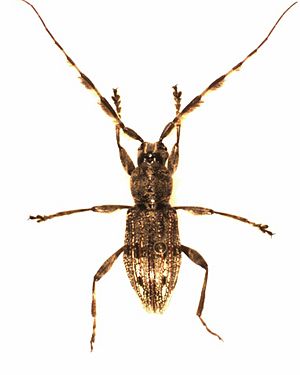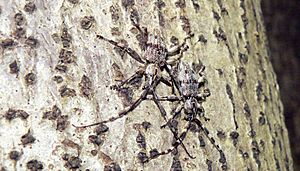Squeaking longhorn facts for kids
Quick facts for kids Squeaking longhorn |
|
|---|---|
 |
|
| Scientific classification | |
| Kingdom: | |
| Phylum: | |
| Class: | |
| Order: | |
| Family: | |
| Genus: |
Hexatricha
|
| Species: |
H. pulverulenta
|
| Binomial name | |
| Hexatricha pulverulenta (Westwood, 1843)
|
|
| Synonyms | |
|
|
The squeaking longhorn (scientific name: Hexatricha pulverulenta) is a special type of beetle that lives only in New Zealand. It's known for the funny squeaking sound it makes when you pick it up! This beetle is the only species in its group, called Hexatricha.
Contents
Meet the Squeaking Longhorn
The squeaking longhorn is a kind of beetle that belongs to the longhorn beetle family. These beetles are famous for their really long antennae, which can sometimes be longer than their bodies! Our squeaking longhorn is unique because it's the only species in its entire group, or "genus," called Hexatricha.
What's in a Name?
The scientific name for this beetle is Hexatricha pulverulenta. It was first described way back in 1843 by a scientist named John O. Westwood. At first, he called it Lamia pulverulenta. Later, it was moved into its own special group, Hexatricha.
The common name, "squeaking longhorn," is very fitting! When you handle this beetle, it makes a squeaking noise. It does this by rubbing parts of its body together, a bit like how a cricket makes sound. This action is called stridulation.
Where Do They Live?
This amazing beetle is found only in New Zealand. This means it is "endemic" to New Zealand, and you won't find it living naturally anywhere else in the world! It's an important part of New Zealand's unique wildlife.
Life Cycle of the Squeaking Longhorn
Like many insects, the squeaking longhorn goes through several stages in its life. This process is called metamorphosis. It starts as an egg, then becomes a larva, then a pupa, and finally, an adult beetle.
Reproduction
Female squeaking longhorn beetles are very careful about where they lay their eggs. They usually choose dead or dying trees. They especially like Pinus radiata trees or New Zealand beech trees (which are part of the Nothofagus family). The female beetle lays her egg right under the bark of these trees.
Larva Stage
After about 10 to 19 days, the eggs hatch into tiny larvae. These larvae are like little grubs. They live under the bark and inside the wood of the tree. They spend a long time here, sometimes two or even three years, munching on the wood! This is how they grow big and strong.
Pupa Stage
Once the larva is fully grown, it changes into a pupa. This is a resting stage, like a chrysalis for a butterfly. The pupa stays hidden for about 30 days. During this time, amazing changes happen inside as the larva transforms into an adult beetle.
Adult Beetles
Adult squeaking longhorn beetles emerge from their pupal stage from spring to autumn, usually between August and April. Once they are adults, they live for up to three months. Even though they have wings, adult squeaking longhorns don't fly very often. They prefer to stay close to their trees.


